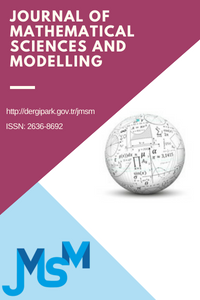Threshold and Stability Results of a New Mathematical Model for Infectious Diseases Having Effective Preventive Vaccine
Threshold and Stability Results of a New Mathematical Model for Infectious Diseases Having Effective Preventive Vaccine
This paper evaluates the impact of an effective preventive vaccine on the control of some infectious diseases by using a new deterministic mathematical model. The model is based on the fact that the immunity acquired by a fully effective vaccination is permanent. Threshold $\mathcal{R}_{0}$, defined as the basic reproduction number, is critical indicator in the extinction or spread of any disease in any population, and so it has a very important role for the course of the disease that caused to an epidemic. In epidemic models, it is expected that the disease becomes extinct in the population if $\mathcal{R}_{0}<1.$ In addition, when $\mathcal{R}_{0}<1$ it is expected that the disease-free equilibrium point of the model, and so the model, is stable in the sense of local and global. In this context, the threshold value $\mathcal{R}_{0}$ regarding the model is obtained. The local asymptotic stability of the disease-free equilibrium is examined with analyzing the corresponding characteristic equation. Then, by proved the global attractivity of disease-free equilibrium, it is shown that this equilibria is globally asymptotically stable.
Keywords:
Vaccine Effect, Diseasefree Equilibrium Point, Basic Reproduction Number, Local Asymptotic Stability, Global Attractivity Global Asymptotic Stability,
___
- [1] S. Cakan, Dynamic analysis of a mathematical model with health care capacity for COVID-19 pandemic, Chaos, Solitons and Fractals, 139, 110033 (2020), 1-8.
- [2] P. Kumar, V.S. Erturk, The analysis of a time delay fractional COVID-19 model via Caputo type fractional derivative, Math Meth Appl Sci., (2020), 1-14. https://doi.org/10.1002/mma.6935
- [3] Z. Zhang, A. Zeb, S. Hussain, E. Alzahrani, Dynamics of COVID-19 mathematical model with stochastic perturbation, Adv. Differ. Equ., 451 (2020), 1-12. https://doi.org/10.1186/s13662-020-02909-1
- [4] W.O. Kermack, A.G. McKendrick, A contributions to the mathematical theory of epidemics, Proc. Roy. Soc. A, 115 (1927), 700-721.
- [5] N.F. Tehrani, M.R. Razvan, S. Yasaman, Global Analysis of a delay SVEIR epidemiological model, Iran. J. Sci. Technol. Trans. A Sci., 37A4 (2013), 483-489.
- [6] R. Xu, Global stability of a delayed epidemic model with latent period and vaccination strategy, Appl. Math. Model., 36 (2012), 5293–5300.
- [7] A.A. Momoh, M.O. Ibrahim, B.A. Madu, Stability Analysis of an infectionus disease free equilibrium of Hepatitis B model, Research Journal of Applied Sciences, Engineering and Technology, 3(9) (2011), 905-909.
- [8] C. Wu, Z. Jiang, Global stability for the disease free equilibrium of a delayed model for malaria transmission, Int. Journal of Math. Analysis, 6(38) (2012), 1877-1881.
- [9] C. Wu and Y. Zhang, Stability Analysis for the disease free equilibrium of a discrete malaria model with two delays, Intelligent Computing Theories and Applications. ICIC 2012, LNAI 7390 (2012), 341-349.
- [10] R. Akbari, A.V. Kamyad, A.A. Heydari, A. Heydari, The analysis of a disease-free equilibrium of hepatitis B model, Sahand Communications in Mathematical Analysis (SCMA), 3(2) (2016), 1-11.
- [11] J.C. Kamgang, G. Sallet, Computation of threshold conditions for epidemiological models and global stability of the disease-free equilibrium (DFE), Math. Biosci., 213 (2008), 1-12.
- [12] J.C. Kamgang, G. Sallet, Global asymptotic stability for the disease free equilibrium for epidemiological models, Comptes Rendus Mathematique, 341(7) (2005), 433-438.
- [13] K.M. Bello, I.N. Akinwande, S. Abdurhman, A.F. Kuta, Y. Bello, Global stability analysis of the disease-free equilibrium state of a mathematical model of trypanosomiasis, J. Appl. Sci. Environ. Manage., 23(2) (2019), 201-208.
- [14] K.B. Blyuss, Y.N. Kyrychko. Instability of disease-free equilibrium in a model of malaria with immune delay. Math Biosci. 248 (2014), 54-6. doi: 10.1016/j.mbs.2013.12.005. Epub 2013 Dec 25. PMID: 24373861.
- [15] S. Lakshmikantham, S. Leela, A.A. Martynyuk, Stability Analysis of Nonlinear Systems, Marcel Dekker, Inc., New York, 1989.
- [16] P.V.D. Driessche, J. Watmough, Reproduction numbers and sub-threshold endemic equilibria for compartmental models of disease transmission, Math.Biosci., 180 (2002), 29-48.
- [17] O. Diekmann, J.A.P. Heesterbeek, J.A.J Metz, On the definition and the computation of the basic reproduction ratio R0 in models for infectious diseases in heterogeneous populations, Journal of Mathematical Biology, 28(4) (1990), 365-382.
- [18] R.H. Thieme, Persitence under relaxed point dissipativity (with application to an endemic model), SIAM J. Math. Anal., 24 (1993), 407-435.
- ISSN: 2636-8692
- Yayın Aralığı: Yılda 3 Sayı
- Başlangıç: 2018
- Yayıncı: Mahmut AKYİĞİT
